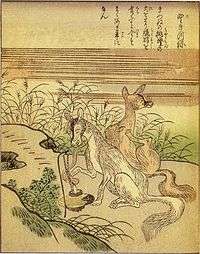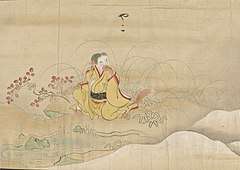Yako (fox)
Yako (野狐) is a spirit possession of foxes (kitsune), as told in Kyushu. To be possessed by it is called "yako-tsuki" (野狐憑き). The yako, literally meaning field foxes, are also called nogitsune.[2]


The appearance of a yako is almost completely consistent among all legends, and unlike real foxes, they are black or white, are slightly larger than a mouse, and smaller than a cat.[3] The original yako is said to be invisible to the eye.[4] In Hirado, Nagasaki Prefecture, they normally bring along a great crowd that walks with them, and thus there is the phrase "yako's thousand-fox company (ヤコの千匹連れ, yako no senbiki ture)."[3]
In Nagasaki Prefecture, Saga Prefecture, and other places in Northern Kyushu, those who are possessed by a yako show symptoms like an illness.[5] On Iki Island, they are also called yako, and since they resemble weasels, it is said that when one of them conceals themselves under a person's armpits, that person would become possessed by a yako. It is said that getting a burn or smallpox scar licked by a yako results in death, and those who have been afflicted with smallpox would go inside a net in order not to get close to a yako, and protected themselves from a yako getting in by either scattering ashes from an epaulette tree or leaving a sword.[3][4]
In Southern Kyushu, family lines would get possessed by a yako, and family lines that raised yako (possessed by a yako) would have their progeny possessed, and if they were no longer able to support it, it would possess its cattle and horses.[3] It is said that the people of families that have a yako could incite the yako to possess those they have bad relations with, and in Kiire, Ibusuki District, Kagoshima Prefecture (now Kagoshima), it is said that becoming possessed by it results in becoming a semi-invalid.[3]
Notes
- 多田克己編 (1997). 竹原春泉 絵本百物語 -桃山人夜話-. 国書刊行会. pp. 158頁. ISBN 978-4-336-03948-4.
- Yōkai no hon written by Prof. Abe Masaji & Prof. Ishikawa Junichiro
- 石塚尊俊 (1977). 日本の憑きもの 俗信は今も生きている. 未來社. pp. 62–66頁.
- 民俗学研究所編著 (1956). 柳田國男監修 (ed.). 綜合日本民俗語彙. 第4巻. 平凡社. pp. 1619–1620頁.
- 宮本袈裟雄他 (1980). 桜井徳太郎編 (ed.). 民間信仰辞典. 東京堂出版. pp. 294頁. ISBN 978-4-490-10137-9.